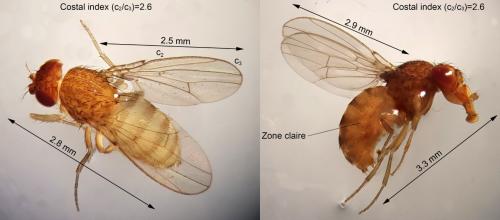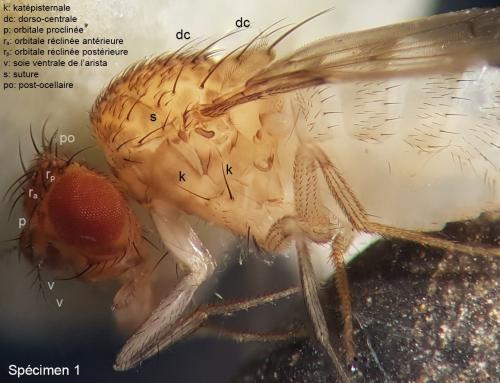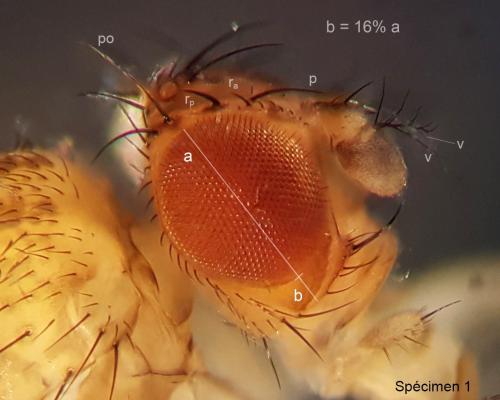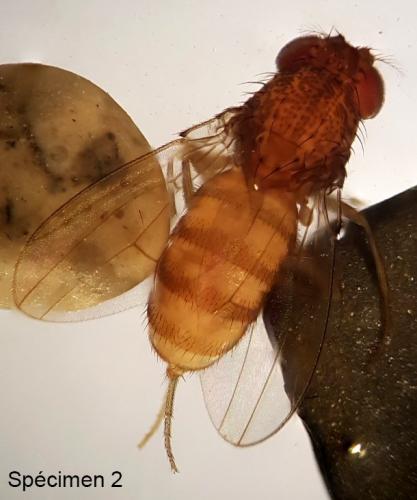Thread subject: Diptera.info :: Drosophila ID
Posted by Widus on 28-11-2020 13:07
#1
Hi,
I can't put a name on these two female Drosophila
specimen. They were collected August 25, 2020 from a jar in which I raised
Culex pipiens f.
molestus larvae that contained a few stems from flowers bought at the market. The jar was closed so the
Drosophila larvae are likely coming from these stems. These two
Drosophila might belong to the
repleta group but none really fit perfectly in my opinion. What do you think?
Christian
P.S. Click on the images to enlarge them.

Christian Widmann : Suisse : Lausanne : 1010 : 25/08/2020
Altitude : 632 m - Taille : Corps (2.8-3.3 mm); ailes (2.5-2.9 mm)
Left, specimen 1; right, specimen 2
Réf. : 271344

Christian Widmann : Suisse : Lausanne : 1010 : 25/08/2020
Altitude : 632 m - Taille : Corps (2.8-3.3 mm); ailes (2.5-2.9 mm)
Réf. : 271346

Christian Widmann : Suisse : Lausanne : 1010 : 25/08/2020
Altitude : 632 m - Taille : Corps (2.8-3.3 mm); ailes (2.5-2.9 mm)
Réf. : 271347

Christian Widmann : Suisse : Lausanne : 1010 : 25/08/2020
Altitude : 632 m - Taille : Corps (2.8-3.3 mm); ailes (2.5-2.9 mm)
Réf. : 271348

Christian Widmann : Suisse : Lausanne : 1010 : 25/08/2020
Altitude : 632 m - Taille : Corps (2.8-3.3 mm); ailes (2.5-2.9 mm)
Réf. : 271349
Edited by Widus on 28-11-2020 13:14
Posted by Jan Maca on 28-11-2020 18:01
#2
Most probably D. repleta (darkened tip of 1st costal section, rather dark eyes, wing of normal length), rather freshly emerged and thus somewhat paler.
Edited by Jan Maca on 28-11-2020 18:05
Posted by Widus on 29-11-2020 09:52
#3
Thank you Jan for your message and providing an explanation for the rather light coloration that put me off the track.
Posted by Widus on 17-12-2021 17:17
#4
I have barcoded one the flies (COX1 sequence). It matches (100%)
Drosophila mercatorum. This species is thought to be native to South America. No wonder I had a hard time to put a name on it.
D. mercatorum has a cosmopolitan distribution and it seems to have reached Switzerland (this would be the first mention to my knowledge)
Edited by Widus on 17-12-2021 17:18
Posted by Carnifex on 17-12-2021 22:58
#5
Interesting find!
Don't know if that feature is of good use in freshly emerged specimen as well, but the fore coxa in
D. repleta is darker than the rest of the leg - here it is the same color.
There is, however, one caveat: According to Bächli,
D. mercatorum should not have a darkend costal spot. Apart from
D. repleta, the other species recorded in Europe with that feature is
D. buzzatii - and that species has light front coxae, and is described to have a small dark band at the base of the tarsus - I think I might spot a faint ring in some of the photos where the leg is visible...
Edited by Carnifex on 17-12-2021 23:08
Posted by Jan Maca on 18-12-2021 11:56
#6
Apparently, the colour characters are sometimes confusing in the repleta group - or the analysis is not 100 % certain? Not long ago I learnt that the dark rings on tibiae (not on tarsi) may be present in D. hydei (Diptera.info 27-09-2019 18:04). In the present specimens, molecular analysis shows that the costal darkening may not be quite certain character.
I determined thes specimens as "most probably repleta" also because repleta is a relatively common species, while mercatorum and buzzatii were not as yet known from well-studied Switzerland. But, with global warming and global exchange of goods, who knows? There are somewhat more than 100 known repleta-group species in the world (see taxodros. uzh.ch).




